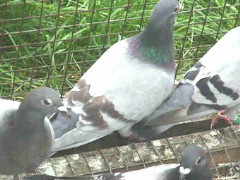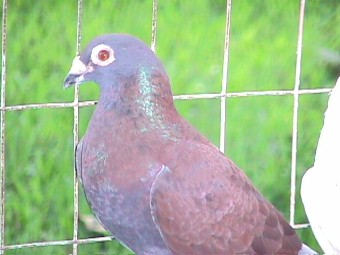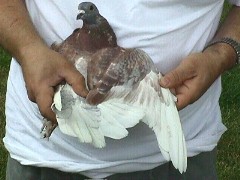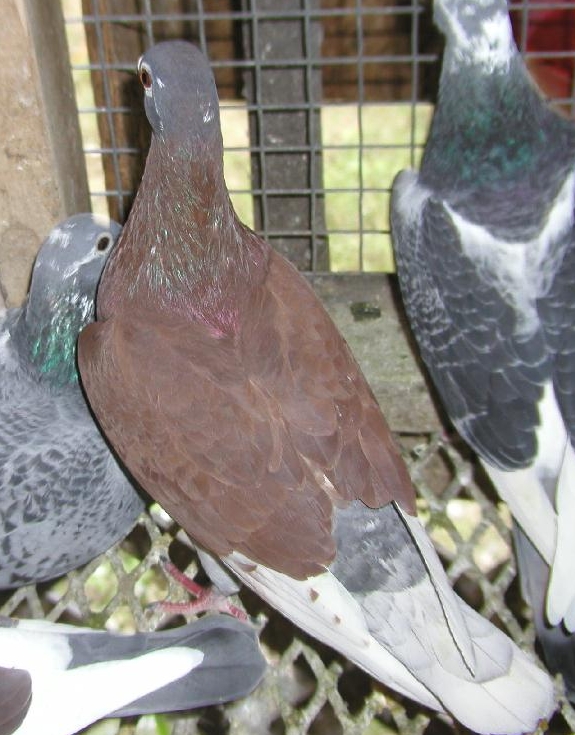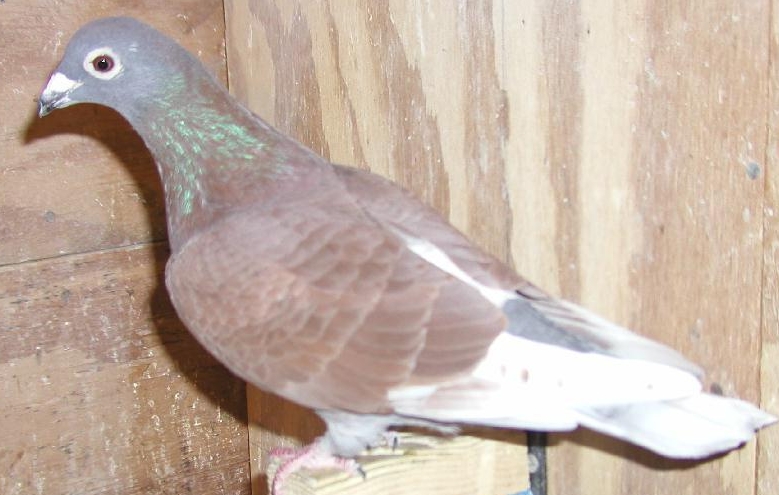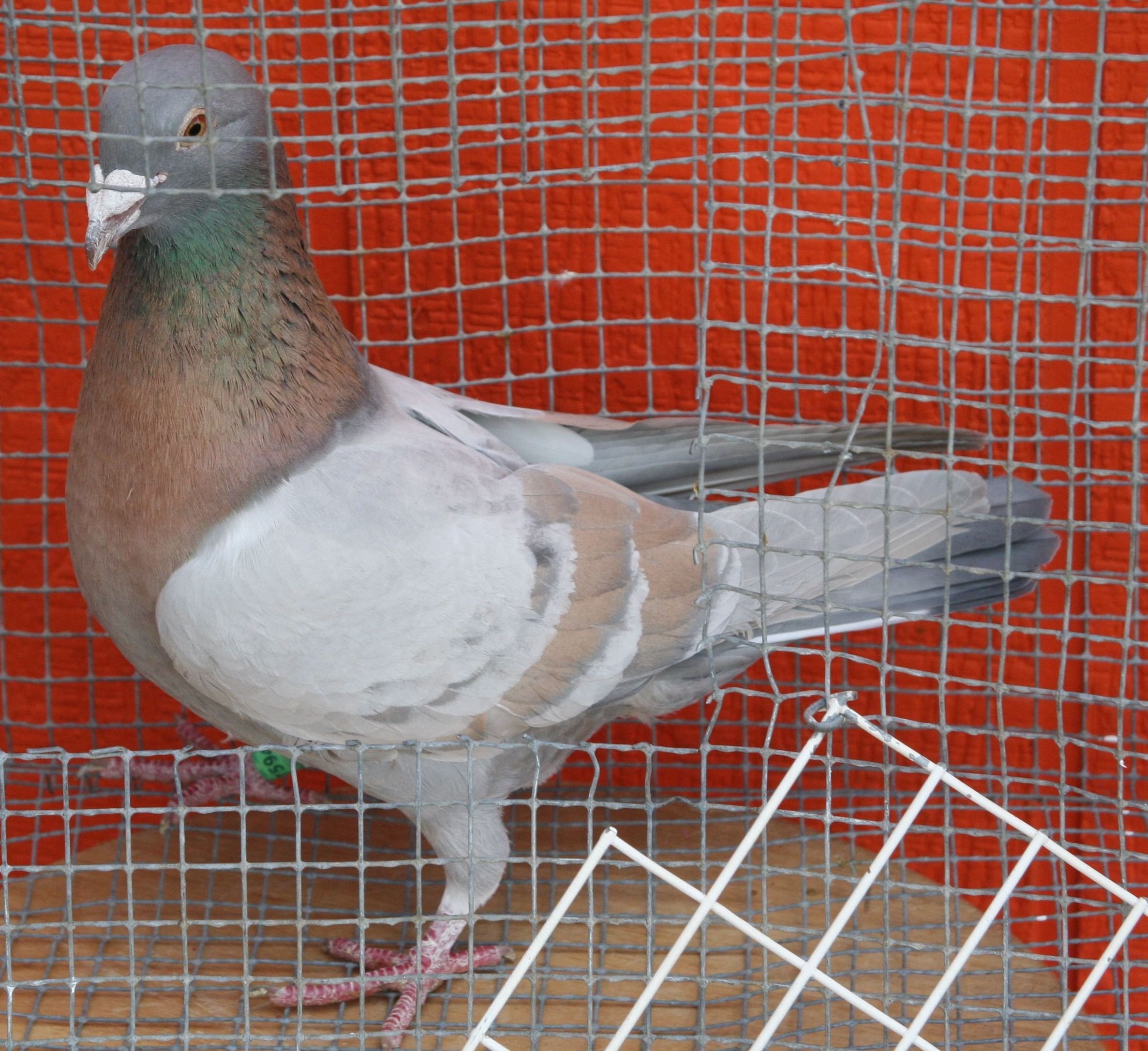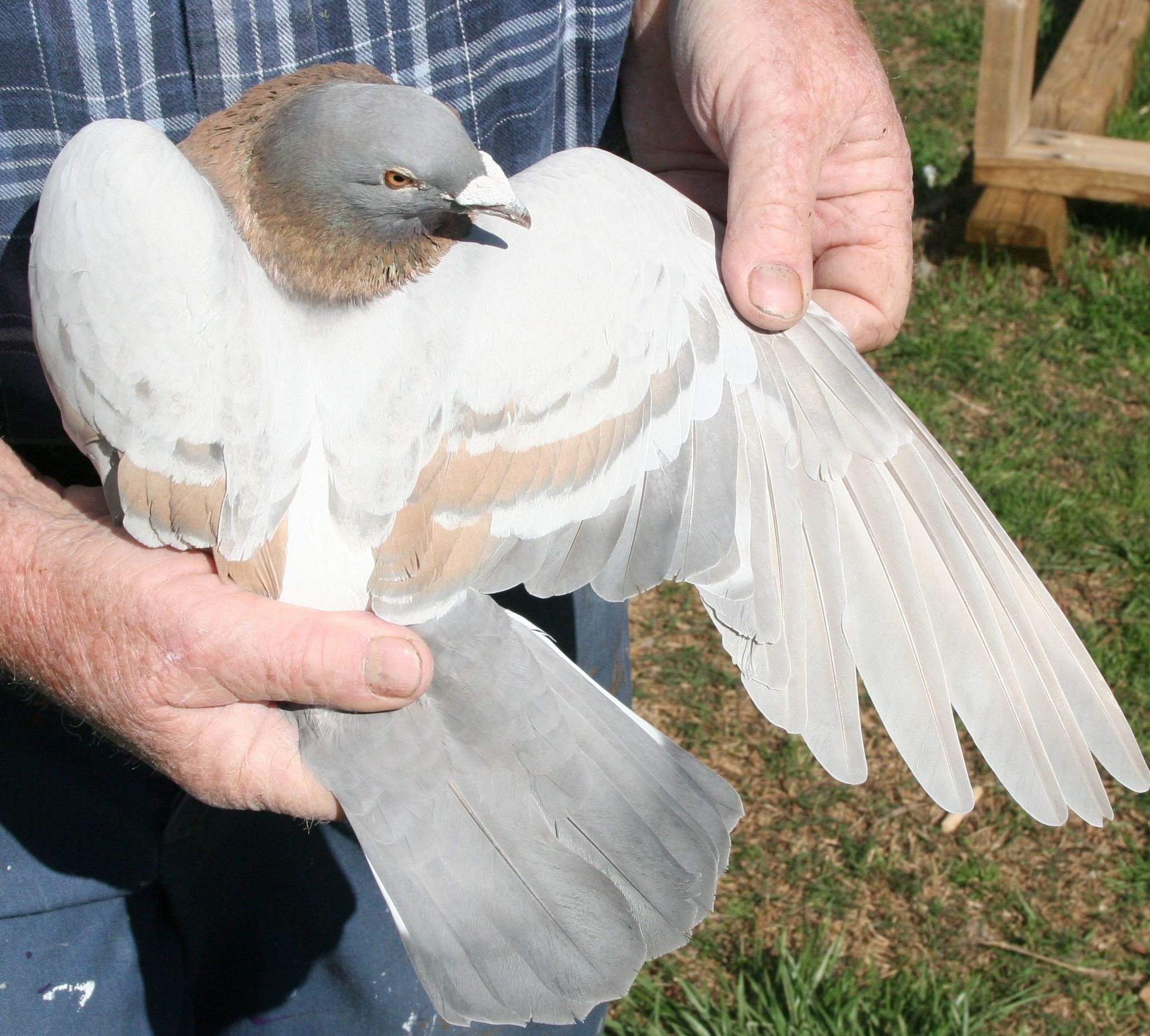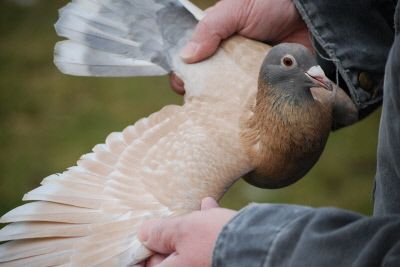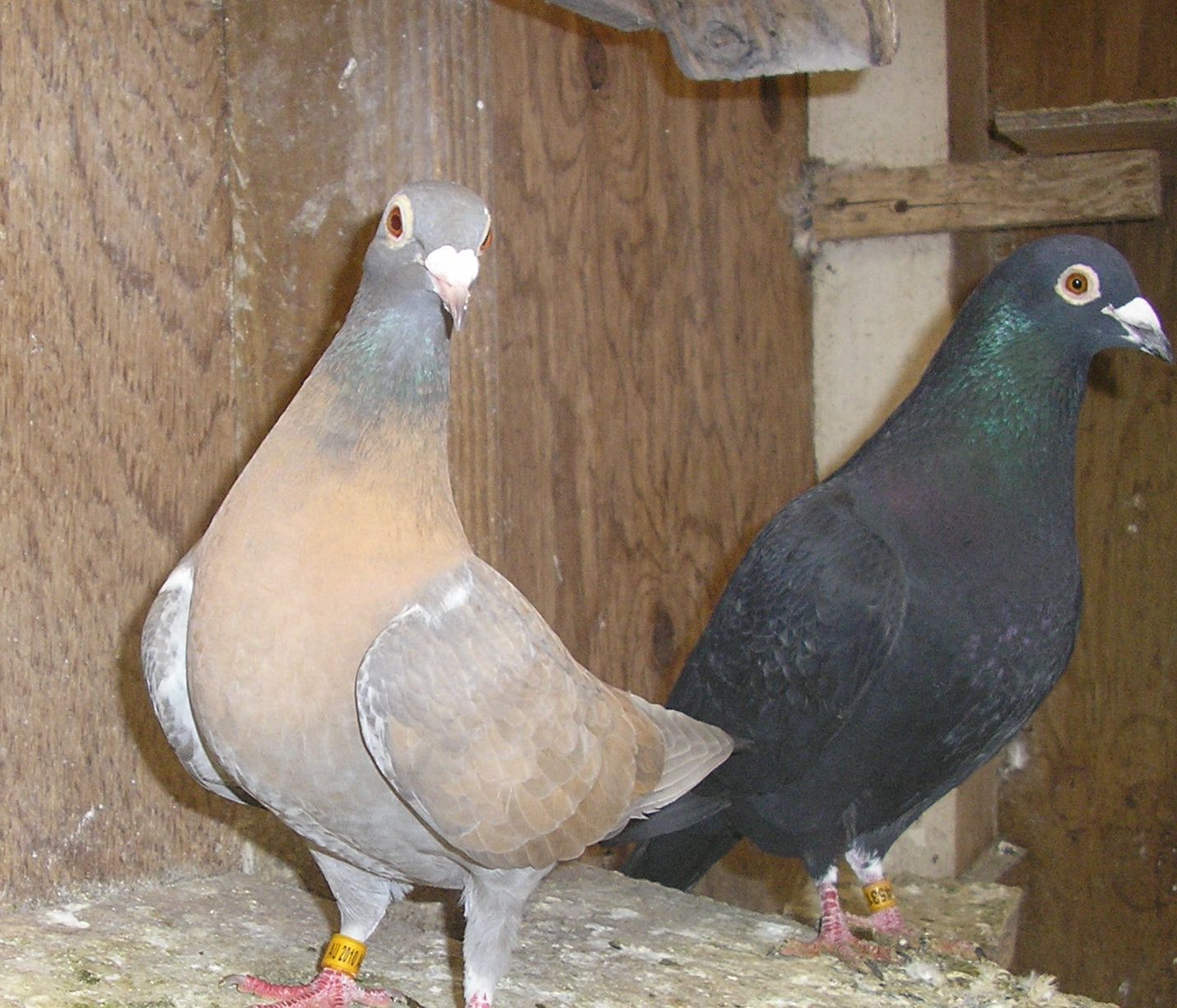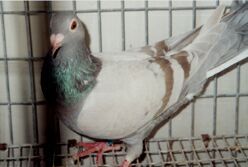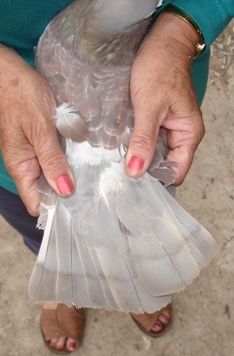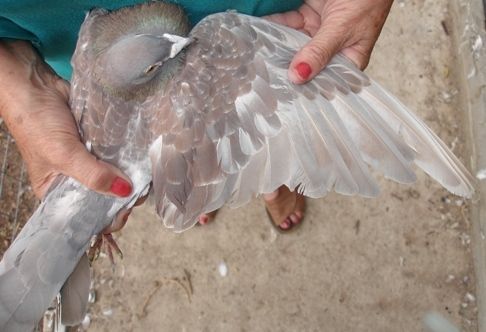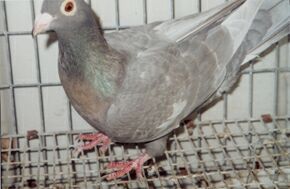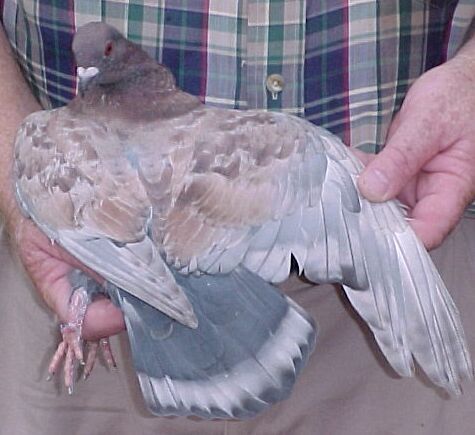Indigo color, pigeons. The Indigo gene with the symbol (In) is a partial dominant autosomal. Autosomal chromosomes are the non sex-linked chromosomes. Therefore their assigned genes such as our Indigo gene are also not going to be sex linked in any way. However you can combine sex-linked genes with indigo to produce many sex-linked phenotypes. However the sex linkage of these phenotypes would not be from the indigo mutation but rather from the other sex-linked ones. Indigo was first noted by Wendell M. Levi in 1936 at his Palmetto Pigeon Plant when he crossed a White Carneau cock with a blue racing homer hen. It was he who gave it the name Indigo. It's true origins are now believed to be from the Carneau line. As a color phenotype, indigo is best expressed when displayed on blue in a heterozygous state. Once you move it from wild type blue to something else; or combine it with other mutations such as dilute or grizzle, it no longer retains its true indigo blue look. The same is true when you go from a heterozygous indigo blue to a homozygous indigo blue. Indigo in the homozygous or pure form takes on an ash red mimic appearance and is no longer indigo blue in color even though it is still genetically a wild type blue at the b locus. Here are some examples of the Indigo gene (symbolized In) as expressed on blue, wild type base color pigeons. You will notice that some of the birds seen below look blue while others look more red. This gene we call Indigo, effects the pattern markings of the body (which are course spread) differently than it does the end markings of both the tail bar and wing feather tips (which is smooth spread). Therefore, indigo is best expressed on a blue color base where it turns the body markings or pattern areas rust red in color while at the same time turning the smooth spread areas into an an andalusian blue . "What is an Andalusian ?" Well if you mix blue paint with black paint you get navy blue. Andalusian as a color is a lot like that. In other words, andalusian in pigeons and navy blue in sweat shirts are both very dark blue and may appear to be black at first glance. It follows then that you can produce a total andalusian bird by combining the genes of a blue pigeon (regardless of it’s pattern) with the gene for Indigo and the gene for Spread. This Spread gene changes the normal pigment dispersal patterns into one which is uniform in distribution over the birds entire body. Thus masking its otherwise normal color pattern. As it turns out this uniform distribution of pigment by the effect of spread is very similar to that normally found on the birds tail bar. Example being a blue bar with a black tail end bar. Thus a spread blue bar becomes a solid black. Since the tail pattern of a Blue Indigo is deep blue due to the effect of indigo and not the normal black color, when the gene for spread is added into the mix you end up with an andalusian or navy blue colored bird which is the same color as the indigo blues andalusian tail. Wait a minute, didn’t I also say that Blue Indigo also looked red. Well yes, I did and they indeed do. Since Indigo effects the pigment of the tail bar differently than the pigment of the pattern markings, we get an entirely different effect in both areas. Indigo changes the wing shield pattern areas which are a form of course spread into a rust red color. The areas where there is smooth spread pigment the color becomes a dark indigo blue. The more pattern marking such as that found on a t-pattern, the more red the bird becoms in apparance. A very good example of this can be seen by the indigo t-pattern velvet of mine sitting in an apel tree at the top of this page. At first glance this bird appears to be an ash red but he is not. What he is, is a typical blue heterozygous indigo with a velvet t-pattern. A blue barless Indigo like the one provided and shown by Al Bayou below is solid deep blue; while both a blue bar and blue checker Indigo are a deep blue with their (course spread) rust colored bars and or rust colored checks. If your birds are carrying velvet or bronze then you get a deep red colored bird with deep blue wing tips and tail like the one of mine, asleep in the apple tree above. This too is an Indigo and is sometimes referred to as an Ash Red look-a-like or mimic. However; a homozygous Indigo will appear even more like an Ash Red in that their wing tips and tail will also become ash in color to complete the mimic effect. Especially the checker patterns which are a true mimics for ash red. For me, a blue indigo velvet which it's deep red body, deep blue tail and blue wing tips is one good looking bird. I love the one shown sitting in my apple tree taking a short nap. He’s a real beauty. Indigo does not express itself nearly as well on either brown or ash red colored pigeons. On brown it looks sort of like an ash red with a brownish tint. There is a pic below from Lame Eagle loft which is one of their brown Indigo checker splash hens. Since beauty is in the eye of the beholder, Lame Eagle describes her as beautiful. Others have described brown indigo as an icky color. I say to each his own but in my opinion I feel it darken and enriches the brown coloration. There are some shown below so you can judge for your self. When it comes to indigo on an ash red, it is more difficult to recognize the indigo effects, as they are hidden by the overall ash red coloration. However; the head of an indigo ash red is always darker that a normal ash red. There is a tendency for the body cover feathers to also be darker when expressed on a check or t-pattern bird. The end result is a deeper red colored pigeon but it takes a keen eye to spot the differences. Normal ash reds tend to have lighter heads with a more washed out ash color face. Indigos, regardless
if they are
on a brown, blue or ash will all have a washed out tail bar.
It is never expressed in its normal color form; which on
brown would be brown, blue would be black and ash would be
ash. Whenever a bird is indigo, it's normal tail
color
will have been modified accordingly. Now check
these out,
their great! |


Indigo Blue Barless and Indigo Blue Bar Above is Al
Bayou's indigo blue barless pattern;
next to it is one of my indigo blue bars for comparison. A
true
blue barless indigo is not the same color as an Andalusian; it is
lighter in shade and not as striking in appearance.
Note
how the pattern markings of the bars
are a rust red color while the body and tail is a deep blue with washed
out ends. This is typical for Indigo on a blue pattern.
This
bar pigeon above is also carrying the gene for sooty which is the
cause for what appears to be a light check effect. However
if these checkered areas were the result of the check pattern
gene,
these markings would also have been modified by Indigo into a rust
color.
Sine Indigo does not effect sooty in this way,
they remain
blue/black. Holding this indigo bar hen is my Grandson
Michael
in
his red shirt.
|
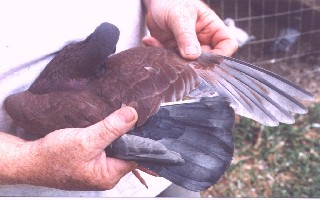 Indigo Velvet Yes, this too is a Blue pigeon (genetically) and not an ash red one. The red velvet appearance is the effect indigo has on what otherwise would have been its bodies course spread black pattern markings. These markings are caused by another gene known as T-Pattern or Velvet. The combination of indigo and t- pattern or velvet has modified this birds head and body into a deep red color. It's wing flights (smooth spread) are deep blue while the tail bar marking (again smooth spread) has become Andalusian blue in color. |
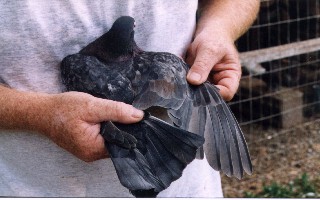 Andalusian or Indigo Spread Andalusian is the spread form of
indigo on a
genetically blue colored pigeon. The gene for
Spread transforms pigment into a very uniform
distribution, similar to that of the tail bar. Therefore on
an indigo blue with its dark andalusian colored tail the spread gene
transforms the birds entire body into what would have normally
been seen on the tail. In other words,
the andalusian blue color of the tail bar becomes the basic color of
the bird. When white markings or non pigmented areas are
present, they
are not effected by the Spread gene effect and these white areas remain
white.
Here
are some more indigo birds to admire.
Some of these photos were taken at my friend Tom Barnhart's loft. There is a link to his excellent page in my pigeon links page.
On the left is an Indigo Bar between two Blue Bars (non-Indigo) in Tom's fly pen. Note the difference in bar colors between these birds. On the right is one of my Indigo Velvets. Note the color contrast between the two. Both are heterozygous indigo on a blue base color so why the vast difference? The answer is simple. Indigo effects the marking pattern colors (course spread pigment distribution areas) on blue by turning it into reddish color thus the rusty red bars. The bird on the right is t-pattern velvet with kite and this bird would appear almost black if it were not for the effects of indigo. Since it has more course spread pigment distribution showing, its a much deeper red than the bared bird with it’s limited amount of course spread pattern (bars) displayed. Both have the same tail appearance which is a dark andalusian color with a slightly washed out tail bar. The pigment arrangement in the tail bar is smooth spread and indigo effects smooth spread differently by turning it into an andalusian color. Had either of these tow birds been a spread then the pigment distribution of the entire body would have been the more uniform typs like that of the smooth spread of the tail and the bird would be seen as an andalusian in phenotype.
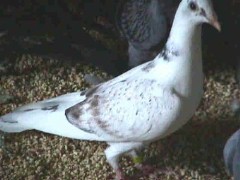
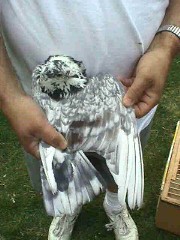 On the left is one of Tom's young
Indigo Grizzles.
On the right is another of Tom's Indigo Grizzles this one an
adult. That's Tom holding his birds for my
camera.
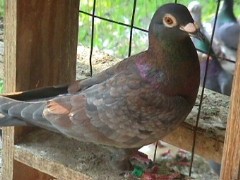
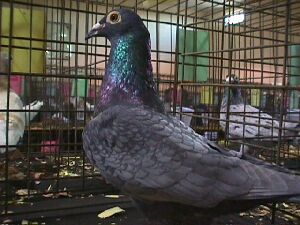 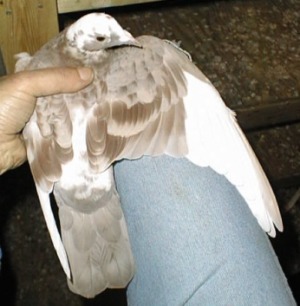 
On the left is a brown indigo checker
splash hen with
white flights and
the gene for dirty. On the Right is a young blue
indigo checker splash with white flights and the gene for dirty.
These two birds are genetically almost the same.
One is on brown the other is on blue.
Both are light checkers with white flights. Both carry the
gene for dirty. Big difference in phenotypes with
only a small difference in genotypes. Note how the
colors change when displayed in combination with brown.
Could it pass for a poorly colored red check?
A Tom Barnhart homozygous Blue Indigo that is a near-perfect mimic for an ash red check. Note how much this homozygous Indigo (double dose of this gene on blue) resembles an ash red checker. Only the darker head and tail help show the presence of indigo.
Kent Hawes of Universal City Texas
sent in these next two homozygous Indigos. They are both very
good
ash red mimics but neither is genetically ash red. Both are
blue, t-patterns with homozygous indigo turning their blue wing
shields, necks and heads into deep red color. However if you
will look closely at their backs there is a trace of deep indigo blue
showing through. This blue coloration on the back tells us
it is
not a normal ash red but rather a blue homozygous indigo or ash red
mimic. Next I would like to show some indigos that are in combination with another mutation known as dilute. Dilute changes the red coloring form red into a golden orange color. These are very attractive pigeons indeed.
These are very attractive pigeons indeed. The two pics of the bared pigeon are mine. The golden t-pattern dilute indigo in the center is from Joe Cussick and the dilute form of andalusian is from Al Bayou. Now lets take a look at some brown indigo birds.. Like I said above, indigo on brown is basically just a darker or richer color of brown. However a quick check of the birds tail will tell us that it is indigo; as the dark brown bar normally found on a brown pigeon has been washed out just as it would be on a blue indigo. This is the best way to spot indigo when in combination with brown; the washed out tail bar and deeper coloration of the brown pigment are the primary telltale signs.
The two pics of the t-pattern bird are from Dr. Wim Peters of South Africa. Sadly I do not remember who submitted the brown spread indigo on the right. If anyone knows please pass the name on to me so i can give proper credit here. Last but not least, I would like to show what I believe is one of my best looking color combinations. Yes it too is an indigo blue, but this time it is in combination with dominant opal and t-pattern. This young bird is going through his first molt. Unfortunately, for both he and I, he went to lunch one afternoon with Mrs. Cooper and never returned. The color contrast between his body and his open tail, when swooping down to the landing board, was an awesome sight to behold. I truly do miss that bird.
Once again I wish to say "Thanks" to all that sent in these lovely photos. |
